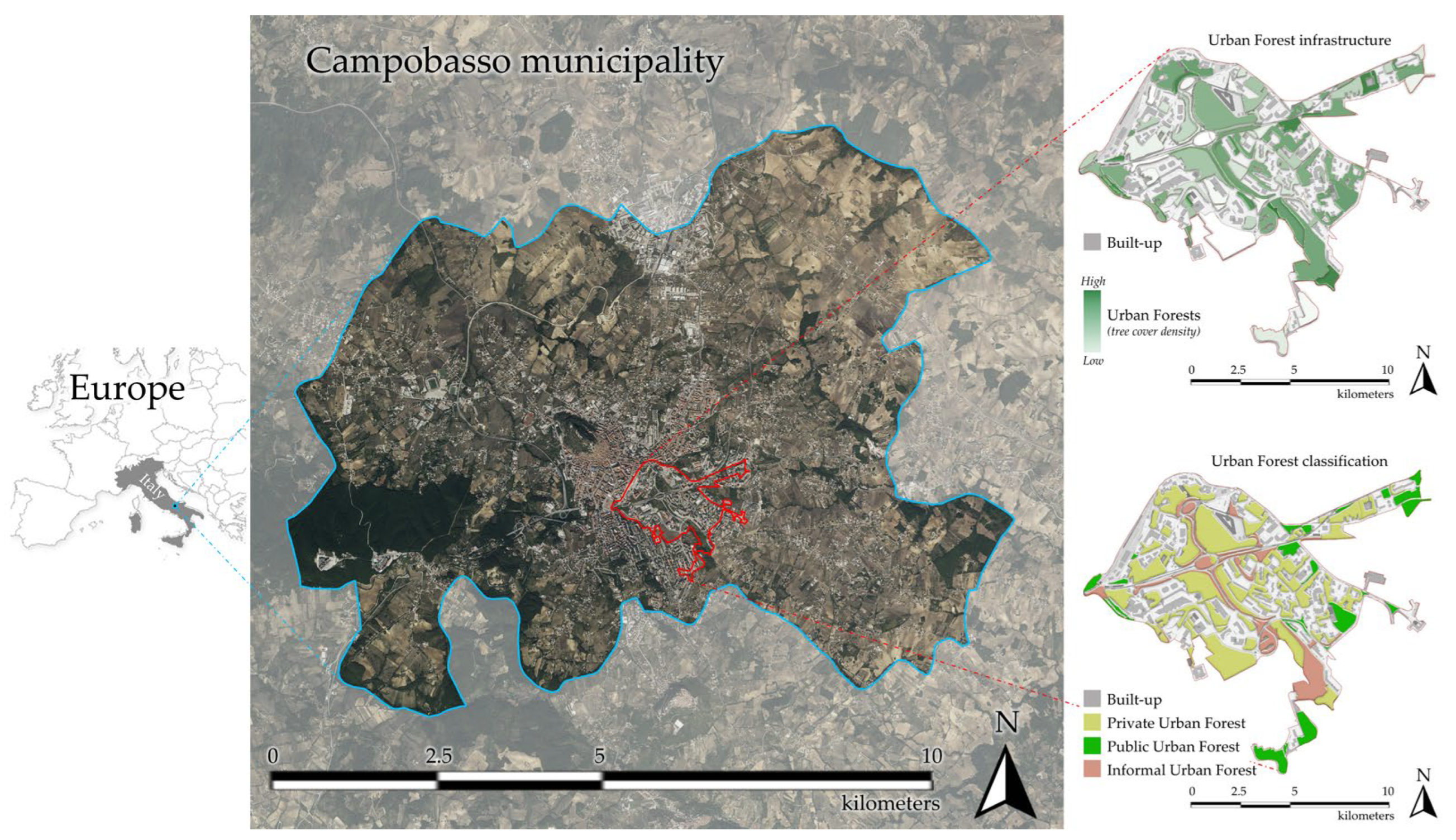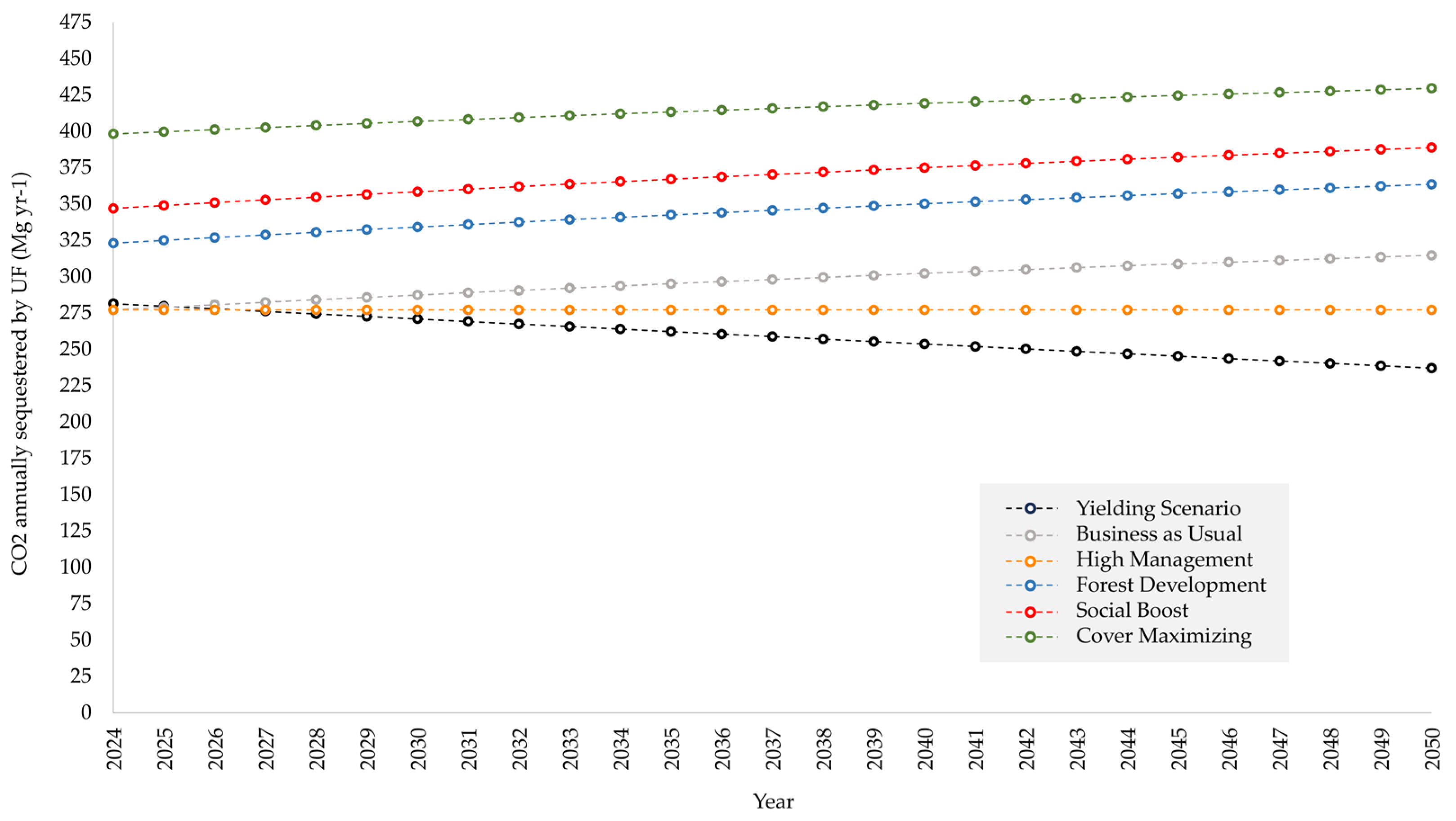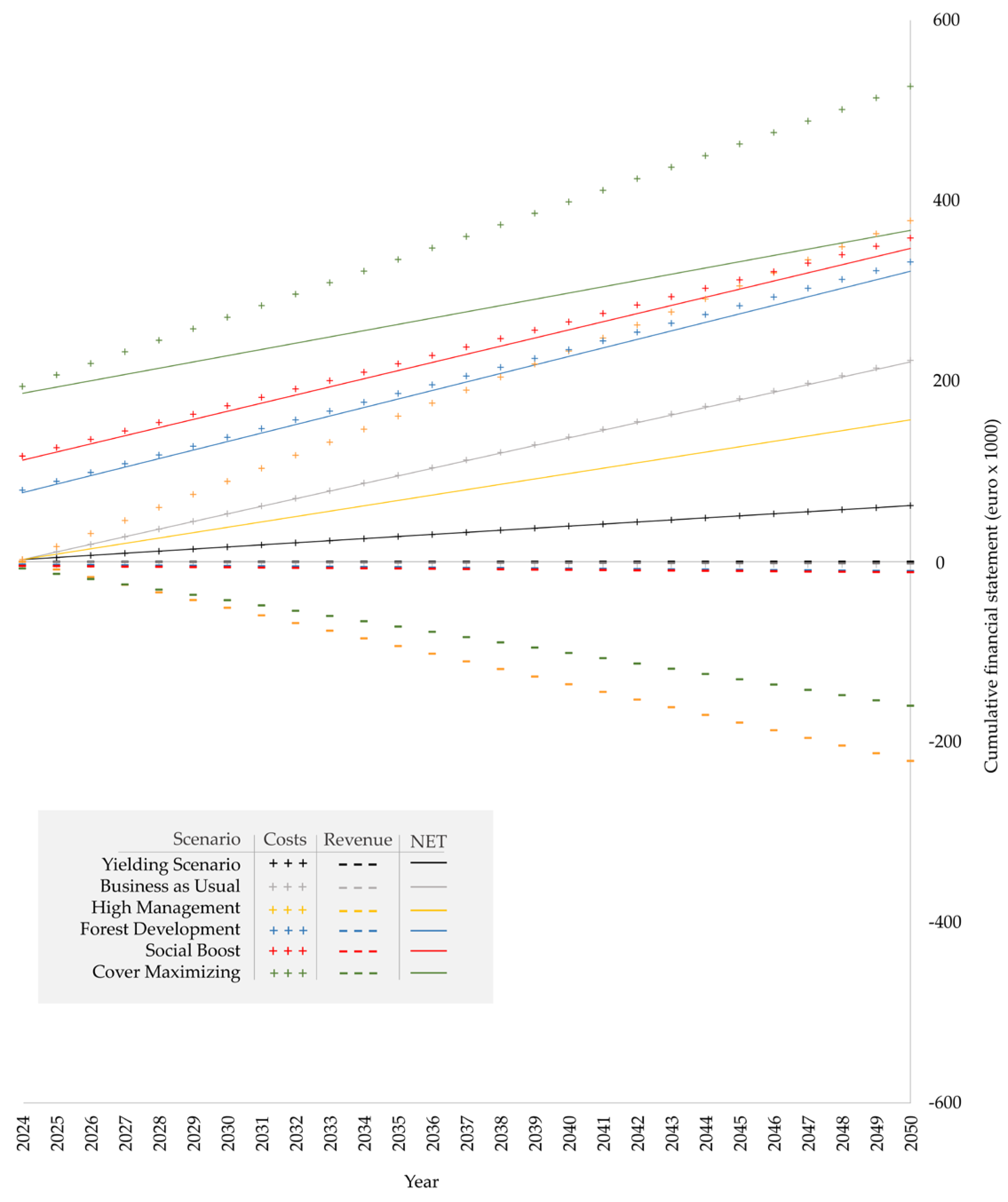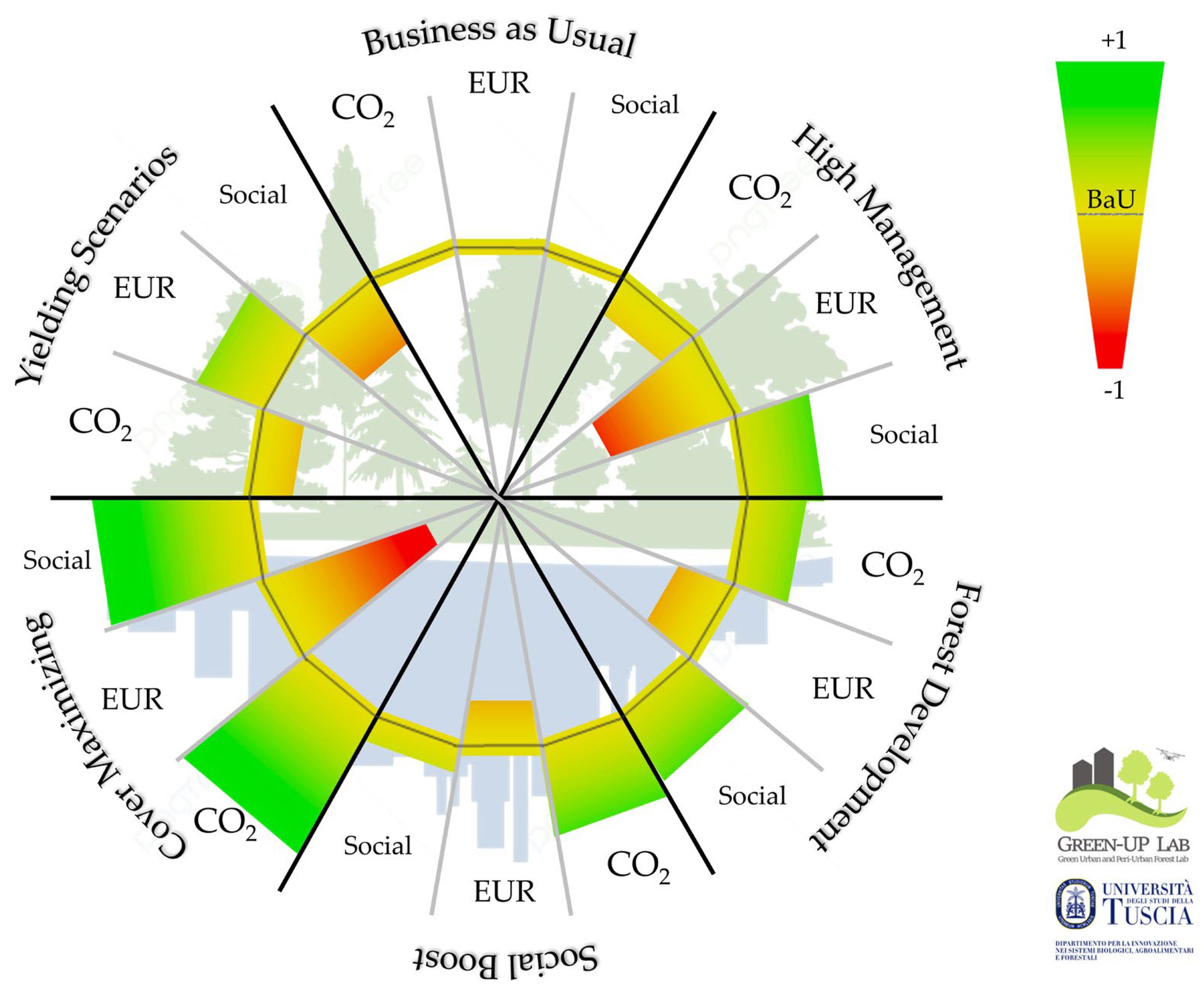Urban Greenprint: A Decision Support Tool for Optimizing Urban Forest Strategies in Sustainable Cities
Abstract
1. Introduction
2. Materials and Methods
2.1. The Testing Area and the Cartographic Database
2.2. Decision Support Tool (DST)
2.3. Urban Forest Management and Scenarios
2.3.1. Management Actions and Interventions Considered in the DST
2.3.2. Urban Forest Management Scenarios
- Yielding Scenario (YS), representing a strategy with minimal intervention. For Pub-UFs, ordinary management is restricted to lawn mowing and tree pruning (basic), without the replacement of dead trees. Inf-UFs remain unmanaged, following natural processes. Priv-UFs are maintained through basic ordinary management, including lawn mowing and tree pruning, without the replacement of dead trees. This scenario serves as a baseline, reflecting minimal investment in the health, appeal, and expansion of UFs by the public administration.
- Business as Usual Scenario (BaU), representing the standard (and current) UF management. Pub-UFs receive full ordinary maintenance (i.e., lawn mowing, tree pruning, and replacement of dead trees). Inf-UFs remain unmanaged, following natural processes. Priv-UFs follow full ordinary management, with the same interventions as Pub-UFs.
- High-Management Scenario (HM), involving more intensive UF management. Pub-UFs are managed with ordinary maintenance, including the replacement of dead trees. Inf-UFs begin receiving the same ordinary management (lawn mowing, tree pruning, and replacement of dead trees) that was previously absent. Priv-UFs also follow the same management approach.
- Forest Development Scenario (FD), employing a proactive approach aimed at increasing UF coverage. Pub-UFs receive full ordinary management, and reforestation actions are conducted in Pub-UFs with less than 50% tree cover to increase coverage to at least 50%. In Pub-UFs where tree cover ranges from 50% to 100%, additional trees are planted to achieve full coverage. Inf-UFs remain unmanaged. Priv-UFs continue with full ordinary management.
- Social Boost Scenario (SB), in which private owners are engaged through incentives to enhance Priv-UF coverage. Specifically, private owners continue to implement full ordinary management of Priv-UFs and are incentivized to increase tree coverage by 20%, supported by green subsidies. Pub-UFs are maintained with full ordinary management, while Inf-UFs remain unmanaged.
- Cover Maximizing Scenario (CM), aimed at maximizing UF coverage through the most intensive UF management. Pub-UFs are maintained with full ordinary management, and reforestation actions are conducted to achieve 50% coverage where current coverage is below this threshold, or 100% coverage where it ranges between 50% and 100%. Inf-UFs begin receiving full ordinary management, and additional reforestation actions are implemented to reach 100% coverage in Inf-UFs with tree cover ranging from 75% to 100%. Priv-UFs continue with full ordinary management, with an additional 20% increase in tree coverage incentivized through green subsidies.
- The UF management scenarios are reported and described in Table 3.
2.4. Cost–Benefit Assessment and Trade-Off Analysis
2.4.1. Environmental Evaluation
2.4.2. Economic Evaluation
2.4.3. Social Evaluation
2.4.4. Trade-Off Evaluation
3. Results
3.1. Environmental Costs and Benefits
3.2. Economic Costs and Benefits
3.3. Social Costs and Benefits
3.4. Environmental, Economic, and Social Trade-Offs
4. Discussion
4.1. Overall Performance of the UF Scenarios
4.2. Final Remarks
5. Conclusions
Supplementary Materials
Author Contributions
Funding
Data Availability Statement
Conflicts of Interest
References
- United Nations (UN), Department of Economic and Social Affairs, Population Division. World Urbanization Prospects: The 2018 Revision (ST/ESA/SER. A/420); United Nations: New York, NY, USA, 2020; Available online: https://www.un.org/en/desa/2018-revision-world-urbanization-prospects (accessed on 10 March 2025).
- Acuto, M.; Parnell, S.; Seto, K.C. Building a global urban science. Nat. Sustain. 2018, 1, 2–4. [Google Scholar] [CrossRef]
- Elmqvist, T.; Andersson, E.; McPhearson, T.; Bai, X.; Bettencourt, L.; Brondizio, E.; Colding, J.; Daily, G.; Folke, C.; Grimm, N.; et al. Urbanization in and for the Anthropocene. NPJ Urban Sustain. 2021, 1, 6. [Google Scholar] [CrossRef]
- United Nations (UN). In Global State of National Urban Policy—Achieving Sustainable Development Goals and Delivering Climate Action; OECD Publishing: Paris, France, 2021; Available online: https://www.oecd.org/en/publications/global-state-of-national-urban-policy-2021_96eee083-en.html (accessed on 10 March 2025).
- James, N. Urbanization and its impact on environmental sustainability. J. Appl. Geogr. Stud. 2024, 3, 54–66. [Google Scholar] [CrossRef]
- Ali, S.; Niaz, H.; Ahmad, S.; Khan, S. Investigating how Rapid Urbanization Contributes to Climate Change and the Social Challenges Cities Face in Mitigating its Effects. Rev. Appl. Manag. Soc. Sci. 2025, 8, 1–16. [Google Scholar] [CrossRef]
- United Nations (UN), Department of Economic and Social Affairs, Population Division. Transforming Our World: The 2030 Agenda for Sustainable Development, General Assembly (A/RES/70/1); United Nations: New York, NY, USA, 2015; Available online: https://sdgs.un.org/2030agenda (accessed on 10 March 2025).
- Addas, A. The importance of urban green spaces in the development of smart cities. Front. Environ. Sci. 2023, 11, 1206372. [Google Scholar] [CrossRef]
- La Torre, M.; Leo, S.; Palma, A.; Zapata, J.D.S. Public spending and green finance: A systematic literature review. Res. Int. Bus. Finance 2024, 68, 102197. [Google Scholar] [CrossRef]
- Toxopeus, H.; Polzin, F. Reviewing financing barriers and strategies for urban nature-based solutions. J. Environ. Manag. 2021, 289, 112371. [Google Scholar] [CrossRef]
- Esperon-Rodriguez, M.; Gallagher, R.; Calfapietra, C.; Cariñanos, P.; Dobbs, C.; Eleuterio, A.A.; Rodriguez , D.E.; Jahani, A.; Litvak, E.; Livesley, S.J.; et al. Barriers and opportunities for resilient and sustainable urban forests. Nat. Cities 2025, 2, 290–298. [Google Scholar] [CrossRef]
- Zhao, D.; Cai, J.; Xu, Y.; Liu, Y.; Yao, M. Carbon sinks in urban public green spaces under carbon neutrality: A bibliometric analysis and systematic literature review. Urban For. Urban Green. 2023, 86, 128037. [Google Scholar] [CrossRef]
- Francini, S.; Chirici, G.; Chiesi, L.; Costa, P.; Caldarelli, G.; Mancuso, S. Global spatial assessment of potential for new peri-urban forests to combat climate change. Nat. Cities 2024, 1, 286–294. [Google Scholar] [CrossRef]
- Nowak, D.J.; Hirabayashi, S.; Doyle, M.; McGovern, M.; Pasher, J. Air pollution removal by urban forests in Canada and its effect on air quality and human health. Urban For. Urban Green. 2018, 29, 40–48. [Google Scholar] [CrossRef]
- Marando, F.; Heris, M.P.; Zulian, G.; Udías, A.; Mentaschi, L.; Chrysoulakis, N.; Parastatidis, D.; Maes, J. Urban heat island mitigation by green infrastructure in European Functional Urban Areas. Sustain. Cities Soc. 2022, 77, 103564. [Google Scholar] [CrossRef]
- di Cristofaro, M.; Di Pirro, E.; Ottaviano, M.; Marchetti, M.; Lasserre, B.; Sallustio, L. Greener or Greyer? Exploring the Trends of Sealed and Permeable Spaces Availability in Italian Built-Up Areas during the Last Three Decades. Forests 2022, 13, 1983. [Google Scholar] [CrossRef]
- Hartig, T.; Kahn, P.H., Jr. Living in cities, naturally. Science 2016, 352, 938–940. [Google Scholar] [CrossRef]
- di Cristofaro, M.; Sallustio, L.; Sitzia, T.; Marchetti, M.; Lasserre, B. Landscape preference for trees outside forests along an urban–rural–natural gradient. Forests 2020, 11, 728. [Google Scholar] [CrossRef]
- Nowak, D.J. Assessing the Benefits and Economic Values of Trees. In Routledge Handbook of Urban Forestry, 1st ed.; Ferrini, F., van den Bosch, C.C.K., Fini, A., Eds.; Routledge handbook of urban forestry: New York, NY, USA, 2017; pp. 152–163, Chapter 11. Available online: https://research.fs.usda.gov/treesearch/54838 (accessed on 10 March 2025).
- Song, X.P.; Tan, P.Y.; Edwards, P.; Richards, D. The economic benefits and costs of trees in urban forest stewardship: A systematic review. Urban For. Urban Green. 2018, 29, 162–170. [Google Scholar] [CrossRef]
- Rahmafitria, F.; Kaswanto, R.L. The role of eco-attraction in the intention to conduct low-carbon actions: A study of visitor behavior in urban forests. Int. J. Tour. Cities 2024, 10, 881–904. [Google Scholar] [CrossRef]
- Mwanzu, A.; Nguyu, W.; Nato, J.; Mwangi, J. Promoting sustainable environments through urban green spaces: Insights from Kenya. Sustainability 2023, 15, 11873. [Google Scholar] [CrossRef]
- Lee, D.H.; Kim, D.H.; Kim, S.I. Characteristics of forest carbon credit transactions in the voluntary carbon market. Clim. Policy 2018, 18, 235–245. [Google Scholar] [CrossRef]
- Papari, C.A.; Toxopeus, H.; Polzin, F.; Bulkeley, H.; Menguzzo, E.V. Can the EU taxonomy for sustainable activities help upscale investments into urban nature-based solutions? Environ. Sci. Policy 2024, 151, 103598. [Google Scholar] [CrossRef]
- van Oorschot, J.; Slootweg, M.; Remme, R.P.; Sprecher, B.; van der Voet, E. Optimizing green and gray infrastructure planning for sustainable urban development. NPJ Urban Sustain. 2024, 4, 41. [Google Scholar] [CrossRef]
- Esperon-Rodriguez, M.; Tjoelker, M.G.; Lenoir, J.; Baumgartner, J.B.; Beaumont, L.J.; Nipperess, D.A.; Power, S.A.; Richard, B.; Rymer, P.D.; Gallagher, R.V. Climate change increases global risk to urban forests. Nat. Clim. Change 2022, 12, 950–955. [Google Scholar] [CrossRef]
- Teixeira, C.P.; Fernandes, C.O.; Ahern, J. Adaptive planting design and management framework for urban climate change adaptation and mitigation. Urban For. Urban Green. 2022, 70, 127548. [Google Scholar] [CrossRef]
- Myers, G.; Mullenbach, L.E.; Jolley, J.A.; Cutts, B.B.; Larson, L.R. Advancing social equity in urban tree planting: Lessons learned from an integrative review of the literature. Urban For. Urban Green. 2023, 89, 128116. [Google Scholar] [CrossRef]
- Antenucci, E.; Di Pirro, E.; di Cristofaro, M.; Garfì, V.; Marchetti, M.; Lasserre, B. Beneficial or impactful management? Life Cycle Assessment and i-Tree Canopy to evaluate the net environmental benefits of Mediterranean urban forests. Urban For. Urban Green. 2025, 107, 128800. [Google Scholar] [CrossRef]
- Roman, L.A.; Conway, T.M.; Eisenman, T.S.; Koeser, A.K.; Barona, C.O.; Locke, D.H.; Jenerette, G.D.; Östberg, J.; Vogt, J. Beyond ‘trees are good’: Disservices, management costs, and tradeoffs in urban forestry. Ambio 2021, 50, 615–630. [Google Scholar] [CrossRef]
- Cueva, J.; Yakouchenkova, I.A.; Fröhlich, K.; Dermann, A.F.; Dermann, F.; Köhler, M.; Grossmann, C.; Meier, W.; Bauhus, J.; Schröder, D.; et al. Synergies and trade-offs in ecosystem services from urban and peri-urban forests and their implication to sustainable city design and planning. Sustain. Cities Soc. 2022, 82, 103903. [Google Scholar] [CrossRef]
- Breyer, B.; Mohr, H. Right tree, right place for whom? Environmental justice and practices of urban forest assessment. Local Environ. 2023, 28, 1082–1096. [Google Scholar] [CrossRef]
- Zhang, B.; MacKenzie, A. Trade-offs and synergies in urban green infrastructure: A systematic review. Urban For. Urban Green. 2024, 94, 128262. [Google Scholar] [CrossRef]
- Cheng, H.; Escobedo, F.J.; Thomas, A.S.; De Los Reyes, J.F.; Ng’ombe, J.N.; Soto, J.R. Understanding how urban communities make trade-offs between forest management and ecosystem service objectives. For. Policy Econ. 2025, 172, 103445. [Google Scholar] [CrossRef]
- Ordóñez, C.; Threlfall, C.G.; Kendal, D.; Hochuli, D.F.; Davern, M.; Fuller, R.A.; van der Ree, R.; Livesley, S.J. Urban forest governance and decision-making: A systematic review and synthesis of the perspectives of municipal managers. Landsc. Urban Plan. 2019, 189, 166–180. [Google Scholar] [CrossRef]
- Albert, C.; Brillinger, M.; Guerrero, P.; Gottwald, S.; Henze, J.; Schmidt, S.; Ott, E.; Schröter, B. Planning nature-based solutions: Principles, steps, and insights. Ambio 2021, 50, 1446–1461. [Google Scholar] [CrossRef]
- Wirtz, Z.; Hagerman, S.; Hauer, R.J.; Konijnendijk, C.C. What makes urban forest governance successful?–A study among Canadian experts. Urban For. Urban Green. 2021, 58, 126901. [Google Scholar] [CrossRef]
- Croeser, T.; Garrard, G.; Sharma, R.; Ossola, A.; Bekessy, S. Choosing the right nature-based solutions to meet diverse urban challenges. Urban For. Urban Green. 2021, 65, 127337. [Google Scholar] [CrossRef]
- Almenar, J.B.; Petucco, C.; Gutiérrez, T.N.; Chion, L.; Rugani, B. Assessing net environmental and economic impacts of urban forests: An online decision support tool. Land 2022, 12, 70. [Google Scholar] [CrossRef]
- Barron, S.; Dunster, K.; Williams, N.S.; Rugel, E.; Kozak, R.; Sheppard, S. A scenario process for urban forest design at the neighbourhood level. Futures 2023, 150, 103172. [Google Scholar] [CrossRef]
- Nyelele, C.; Kroll, C.N. A multi-objective decision support framework to prioritize tree planting locations in urban areas. Landsc. Urban Plan. 2021, 214, 104172. [Google Scholar] [CrossRef]
- Lumeng, L.I.U.; Jianguo, W.U. Scenario analysis in urban ecosystem services research: Progress, prospects, and implications for urban planning and management. Landsc. Urban Plan. 2022, 224, 104433. [Google Scholar] [CrossRef]
- Yadav, N.; Rakholia, S.; Yosef, R. Decision Support Systems in Forestry and Tree-Planting Practices and the Prioritization of Ecosystem Services: A Review. Land 2024, 13, 230. [Google Scholar] [CrossRef]
- Rötzer, T.; Moser-Reischl, A.; Rahman, M.A.; Grote, R.; Pauleit, S.; Pretzsch, H. Modelling urban tree growth and ecosystem services: Review and perspectives. Prog. Bot. 2021, 82, 405–464. [Google Scholar] [CrossRef]
- Almenar, J.B.; Petucco, C.; Sonnemann, G.; Geneletti, D.; Elliot, T.; Rugani, B. Modelling the net environmental and economic impacts of urban nature-based solutions by combining ecosystem services, system dynamics and life cycle thinking: An application to urban forests. Ecosyst. Serv. 2023, 60, 101506. [Google Scholar] [CrossRef]
- Italian Ministry of Infrastructures and Transport (MIT). National Innovative Program for the Quality of Living. 2021. Available online: https://www.mit.gov.it/nfsmitgov/files/media/notizia/2022-04/Rapporto_Pinqua_web.pdf (accessed on 10 March 2025).
- Sallustio, L.; Quatrini, V.; Geneletti, D.; Corona, P.; Marchetti, M. Assessing land take by urban development and its impact on carbon storage: Findings from two case studies in Italy. Environ. Impact Assess. Rev. 2015, 54, 80–90. [Google Scholar] [CrossRef]
- Italian Ministry of Ecological Transition (MITE). National Urban and Extra-Urban Forest Plan. 2021. Available online: https://www.mase.gov.it/portale/documents/d/guest/pnrr_piano_forestazione-pdf (accessed on 10 March 2025).
- Italian Ministry of Agricultural, Food and Forestry Policies (MiPAAF). National Forest Strategy. 2022. Available online: https://www.reterurale.it/foreste/StrategiaForestaleNazionale (accessed on 10 March 2025).
- National Oceanic and Atmospheric Administration (NOAA). Paleo Data Search. 2024. Available online: https://www.ncei.noaa.gov/access/paleo-search/ (accessed on 10 March 2025).
- Hemery, G.E.; Savill, P.S.; Pryor, S.N. Applications of the crown diameter–stem diameter relationship for different species of broadleaved trees. For. Ecol. Manag. 2005, 215, 285–294. [Google Scholar] [CrossRef]
- Oldfield, E.E.; Warren, R.J.; Felson, A.J.; Bradford, M.A. Challenges and future directions in urban afforestation. J. Appl. Ecol. 2013, 50, 1169–1177. [Google Scholar] [CrossRef]
- Rebele, F.; Lehmann, C. Twenty years of woodland establishment through natural succession on a sandy landfill site in Berlin, Germany. Urban For. Urban Green. 2016, 18, 182–189. [Google Scholar] [CrossRef]
- Hilbert, D.R.; Roman, L.A.; Koeser, A.K.; Vogt, J.; van Doorn, N.S. Urban tree mortality: A literature review. Arboric. Urban For. 2019, 45, 167–200. [Google Scholar] [CrossRef]
- European Commission (EC). EU Mission: Climate-Neutral and Smart Cities. 2021. Available online: https://research-and-innovation.ec.europa.eu/ (accessed on 10 March 2025).
- ISO 14040:2006; Environmental Management. Life Cycle Assessment—Principle and Framework. International Organization for Standardization: Geneva, Switzerland, 2006. Available online: https://www.iso.org/standard/37456.html (accessed on 10 March 2025).
- Wernet, G.; Bauer, C.; Steubing, B.; Reinhard, J.; Moreno-Ruiz, E.; Weidema, B. The ecoinvent database version 3 (part I): Overview and methodology. Int. J. Life Cycle Assess. 2016, 21, 1218–1230. [Google Scholar] [CrossRef]
- Huijbregts, M.A.; Steinmann, Z.J.; Elshout, P.M.; Stam, G.; Verones, F.; Vieira, M.D.M.; Zijp, M.; Hollander, A.; van Zelm, R. ReCiPe 2016: A harmonised life cycle impact assessment method at midpoint and endpoint level. Int. J. Life Cycle Assess. 2017, 22, 138–147. [Google Scholar] [CrossRef]
- Nowak, D.J. Understanding i-Tree: 2021 summary of programs and methods. In General Technical Report NRS-200–2021; Department of Agriculture: Madison, WI, USA, 2021; pp. 1–100. Available online: https://www.fs.usda.gov/nrs/pubs/gtr/gtr_nrs200-2021.pdf (accessed on 10 March 2025).
- European Securities and Markets Authority (ESMA), Economics, Financial Stability and Risk Department. ESMA Market Report on EU carbon markets, 2024. Available online: http://www.esma.europa.eu/ (accessed on 10 March 2025).
- Biernacka, M.; Kronenberg, J. Classification of institutional barriers affecting the availability, accessibility and attractiveness of urban green spaces. Urban For. Urban Green. 2018, 36, 22–33. [Google Scholar] [CrossRef]
- Sneath, P.H. Thirty years of numerical taxonomy. Syst. Biol. 1995, 44, 281–298. [Google Scholar] [CrossRef]
- Ordóñez, C.; Threlfall, C.G.; Livesley, S.J.; Kendal, D.; Fuller, R.A.; Davern, M.; van der Ree, R.; Hochuli, D.F. Decision-making of municipal urban forest managers through the lens of governance. Environ. Sci. Policy 2020, 104, 136–147. [Google Scholar] [CrossRef]
- Muscas, D.; Petrucci, R.; Orlandi, F.; Torre, L.; Fornaciari, M. Life cycle assessment of common urban trees-The environmental performance of three Mediterranean cities. Sci. Total. Environ. 2024, 954, 176690. [Google Scholar] [CrossRef]
- Robinson, S.L.; Lundholm, J.T. Ecosystem services provided by urban spontaneous vegetation. Urban Ecosyst. 2012, 15, 545–557. [Google Scholar] [CrossRef]
- Endreny, T.; Santagata, R.; Perna, A.; De Stefano, C.; Rallo, R.F.; Ulgiati, S. Implementing and managing urban forests: A much needed conservation strategy to increase ecosystem services and urban wellbeing. Ecol. Model. 2017, 360, 328–335. [Google Scholar] [CrossRef]
- Suhane, S.; Sharma, U.; Agrawal, R.; Singh, S.P. Integrating Urban Forests into Sustainable Urban Planning: Strategies, Challenges and Future Directions. Int. J. Environ. Sci. 2024, 10, 2229–7359. [Google Scholar] [CrossRef]
- Fitch, E.R.; Tyrna, A.; Lusk, M.G. A comparative study of the secondary benefits of stormwater ponds in economically distinct neighborhoods of Tampa, Florida USA. Discov. Water 2024, 4, 83. [Google Scholar] [CrossRef]
- Vogt, J.; Hauer, R.J.; Fischer, B.C. The costs of maintaining and not maintaining the urban forest: A review of the urban forestry and arboriculture literature. Arboric. Urban For. 2015, 41, 293–323. [Google Scholar] [CrossRef]
- Ostoić, S.K.; Vuletić, D.; Kičić, M. Exploring the negative perceptions of tree-based urban green space. People’s behaviour and management are crucial. Urban For. Urban Green. 2024, 101, 128539. [Google Scholar] [CrossRef]
- Amati, M.; Tiede, J.; Sun, Q.C.; Deilami, K.; Hurley, J.; Fox, A.; Dickson, J. Using machine learning to identify urban forest crown bounding boxes (CBB): Exploring a new method to develop urban forest policy. Urban For. Urban Green. 2023, 85, 127943. [Google Scholar] [CrossRef]
- Luo, S.; Patuano, A. Multiple ecosystem services of informal green spaces: A literature review. Urban For. Urban Green. 2023, 81, 127849. [Google Scholar] [CrossRef]




| Infrastructures Within the Testing Area | Coverage (ha) | ||
|---|---|---|---|
| Sealed area | 69.9 | ||
| Non-forested (Grassland and brownfields) | 25.0 | ||
| Urban forests (UFs) | Private Urban Forests (Priv-UFs) | 17.0 | |
| Collective Urban Forests (Col-UFs) | Managed (Pub-UFs) | 3.3 | |
| Informal (Inf-UFs) | 5.6 | ||
| Model | References | Application | ||
|---|---|---|---|---|
| Priv-UF | Pub-UF | Inf-UF | ||
| Canopy growth | [29] | Ci = π/4 · (Dbhi · K/d)2 | ||
| Forest expansion | [52,53] | None | None | +4.4% surface yr−1 |
| Tree mortality | [54] | +0.7% dead trees yr−1 | +1.4% dead trees per year | +2.8% dead trees yr−1 |
| Scenario | Urban Forest | Interventions | ||||
|---|---|---|---|---|---|---|
| Lawn Mowing | Tree Pruning | Dead Tree Replacement | Reforestation Actions | |||
| Yielding Scenario | Pub-UF | Yes | Yes | No | No | |
| Inf-UF | No | No | No | No | ||
| Priv-UF | Yes | Yes | No | No | ||
| Business as Usual | Pub-UF | Yes | Yes | Yes | No | |
| Inf-UF | No | No | No | No | ||
| Priv-UF | Yes | Yes | Yes | No | ||
| High Management | Pub-UF | Yes | Yes | Yes | No | |
| Inf-UF | Yes | Yes | Yes | No | ||
| Priv-UF | Yes | Yes | Yes | No | ||
| Forest Development | Pub-UF | Yes | Yes | Yes | Yes | <50% to 50% UF cover, and 50–99% to full cover |
| Inf-UF | No | No | No | No | ||
| Priv-UF | Yes | Yes | Yes | No | ||
| Social Boost | Pub-UF | Yes | Yes | Yes | No | |
| Inf-UF | No | No | No | No | ||
| Priv-UF | Yes | Yes | Yes | Yes | +20% UF cover | |
| Cover Maximizing | Pub-UF | Yes | Yes | Yes | Yes | <50% to 50% UF cover, and 50−99% to full cover |
| Inf-UF | Yes | Yes | Yes | Yes | 75–99% to full cover | |
| Priv-UF | Yes | Yes | Yes | Yes | +20% UF cover | |
| Scenario | Cumulative CO2 Emitted (Mg) | ||
|---|---|---|---|
| Basic Ordinary Management | Dead Tree Replacement | Reforestation | |
| Yielding Scenario | 1639.3 | - | - |
| Business as Usual | 1781.6 | 54.5 | - |
| High Management | 1852.8 | 80.3 | - |
| Forest Development | 1800.4 | 64.1 | 26.2 |
| Social Boost | 2071.5 | 61.7 | 39.1 |
| Cover Maximizing | 2134.8 | 76.8 | 65.4 |
| Scenario | UF Social Indicator | Coverage (ha) | |
|---|---|---|---|
| 2024 | 2050 | ||
| Yielding Scenario | Availability | 25.9 | 23.7 |
| Accessibility | 8.9 | 9.6 | |
| Attractiveness | 3.3 | 2.3 | |
| Business as Usual | Availability | 25.9 | 27.6 |
| Accessibility | 8.9 | 10.6 | |
| Attractiveness | 3.3 | 3.3 | |
| High Management | Availability | 25.9 | 25.9 |
| Accessibility | 8.9 | 8.9 | |
| Attractiveness | 3.3 | 8.9 | |
| Forest Development | Availability | 27.9 | 29.6 |
| Accessibility | 10.9 | 12.6 | |
| Attractiveness | 5.4 | 5.4 | |
| Social Boost | Availability | 28.9 | 30.6 |
| Accessibility | 8.9 | 10.6 | |
| Attractiveness | 3.3 | 3.3 | |
| Cover Maximizing | Availability | 31.0 | 32.2 |
| Accessibility | 10.9 | 12.1 | |
| Attractiveness | 5.4 | 9.1 | |
Disclaimer/Publisher’s Note: The statements, opinions and data contained in all publications are solely those of the individual author(s) and contributor(s) and not of MDPI and/or the editor(s). MDPI and/or the editor(s) disclaim responsibility for any injury to people or property resulting from any ideas, methods, instructions or products referred to in the content. |
© 2025 by the authors. Licensee MDPI, Basel, Switzerland. This article is an open access article distributed under the terms and conditions of the Creative Commons Attribution (CC BY) license (https://creativecommons.org/licenses/by/4.0/).
Share and Cite
di Cristofaro, M.; Moresi, F.V.; Maesano, M.; Lasserre, B.; Scarascia-Mugnozza, G. Urban Greenprint: A Decision Support Tool for Optimizing Urban Forest Strategies in Sustainable Cities. Urban Sci. 2025, 9, 216. https://doi.org/10.3390/urbansci9060216
di Cristofaro M, Moresi FV, Maesano M, Lasserre B, Scarascia-Mugnozza G. Urban Greenprint: A Decision Support Tool for Optimizing Urban Forest Strategies in Sustainable Cities. Urban Science. 2025; 9(6):216. https://doi.org/10.3390/urbansci9060216
Chicago/Turabian Styledi Cristofaro, Marco, Federico Valerio Moresi, Mauro Maesano, Bruno Lasserre, and Giuseppe Scarascia-Mugnozza. 2025. "Urban Greenprint: A Decision Support Tool for Optimizing Urban Forest Strategies in Sustainable Cities" Urban Science 9, no. 6: 216. https://doi.org/10.3390/urbansci9060216
APA Styledi Cristofaro, M., Moresi, F. V., Maesano, M., Lasserre, B., & Scarascia-Mugnozza, G. (2025). Urban Greenprint: A Decision Support Tool for Optimizing Urban Forest Strategies in Sustainable Cities. Urban Science, 9(6), 216. https://doi.org/10.3390/urbansci9060216








